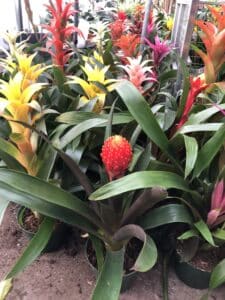
Bromeliad plants are very adaptable, and there is a variety for every light condition. If your bromeliad has thin green leaves it can survive in low light. If it t has thick gray leaves, it needs medium light. The flowers (colorful “bracts”) of a bromeliad plant fade quickly and the leaves turn pale green if it’s placed in very bright light. The leaves get further apart and turn dark green when the plant needs more light.
Bromeliad plants are drought resistant succulents that like dry soil. These houseplants have very small roots and over-watering is the number one reason bromeliads die. Some have “tanks” that like being filled with water; but be sure to empty the leaves weekly if it’s indoors.
Bromeliads are tropical plants that can survive in temperatures between 40-100 degrees, but prefer 70-75 degrees during the day and ten degrees cooler at night. The blooms on Bromeliad houseplants last longer when the temperature is cool.
Bromeliad plants grow well in basic household humidity.
Less intense light and cooler temperatures help bromeliad flowers stay colorful longer. Indoor bromeliad plants bloom only once. As the bromeliad flower starts to die, the plant produces “pups,” baby plants around the base of the mother plant. Cut off the dying flower, so the plant can direct its energy to helping the “pups” grow.
Once the bromeliad blooms die, small plants called offsets or pups grow around the base of the plant. When these offsets are several inches tall, dig them out and plant them in a 4” pot of loose soil. Be careful not to over-water the new plants while the roots are developing.These new plants usually bloom in 1-3 years.
